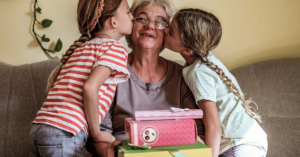Creating a dementia-friendly space is a crucial undertaking for families and caregivers. As dementia progresses, adapting to the living environment can greatly enhance safety, reduce anxiety, and preserve the dignity of people living with dementia.
These modifications also have added benefits for family caregivers, providing a sense of peace and relief from the constant worry about potential accidents or disorientation that may affect their loved ones.
For long-term care homes, implementing dementia-friendly design principles supports a safer, more engaging, and less restrictive setting, allowing residents to experience a sense of freedom to explore and get familiar with their new environment. For frontline care professionals, a well-designed environment means that they can spend more time on meaningful engagement and personalized care rather than constant redirection or addressing safety concerns.
Encouraging Independence in the Comfort of Home in Early-Stage Dementia
In the early stages of dementia, individuals may still live independently, although they may start showing signs of forgetfulness, trouble with decision-making, and difficulty navigating familiar routines (World Health Organization, 2022). During this phase, the goal is to simplify and organize their home to support independence while addressing safety concerns.
Declutter and Simplify
Clearing spaces of unnecessary items can help reduce confusion and prevent tripping hazards. Minimizing clutter in key areas such as the kitchen, bathroom, and bedroom can make everyday tasks easier and reduce overstimulation (Alzheimer’s Society, 2021). Label cabinets and drawers to help them locate essential items without frustration.
Enhanced Lighting
Dementia can affect visual perception, making shadows and dim spaces confusing or frightening. Ensure each room is well-lit, and consider installing motion-sensor lights in hallways and bathrooms to prevent nighttime falls (Fleming & Bennett, 2015).
Memory Aids and Orientation Cues
Introducing memory aids, such as a large, easy-to-read clock and a calendar with the day’s schedule, can reduce confusion about dates and routines (National Institute on Aging, 2024). Magnetic boards or digital displays can also help list daily activities and reminders. Label rooms or place signs in familiar areas as gentle orientation cues.
Creating a “Home Away from Home” for Mid-to-Late Stage Dementia
As dementia advances, it may no longer be safe for someone to live alone, and a transition to a care facility or shared family home may be necessary. This change can be unsettling, so it is essential to make their new environment feel welcoming and familiar. Below are a few tips on how to ease the transition, making it more gradual and manageable.
Incorporate Familiar Items that the Person Will Recognize
Bring personal items, such as favourite blankets, family photos, and cherished keepsakes, to foster a sense of continuity. Familiar items serve as grounding anchors and can ease the transition, helping preserve emotional connections to the past.
Maintain Consistent Routines
In a new environment, familiar routines can help reduce anxiety and confusion. Set regular mealtimes, recreational activities, and sleep schedules that align with their established habits as closely as possible (World Health Organization, 2022). Effective communication and collaboration with care home staff are vital for seamlessly integrating the individual’s routines into the existing schedules of other residents. This approach not only facilitates a smoother transition for the individual but also minimizes disruption for others. While achieving this delicate balance can be challenging, careful planning and consideration can lead to a positive outcome for everyone involved.
Encourage Social Connections
Schedule regular visits and calls from family and friends to provide emotional stability and boost mood. A “Visitor’s Calendar” can list upcoming visits, noting who will visit and when which not only reassures them of their loved ones’ presence but also helps them look forward to time spent with familiar faces. It’s crucial to follow through with these commitments, as consistency fosters trust and security. If a visit cannot be made, consider making a quick phone call or leaving a personalized note to express care and maintain that connection, ensuring the individual feels valued and supported.
Creating a dementia-friendly environment, whether at home or in a new living space, demands patience, empathy, careful planning, and collaboration among everyone involved, including, when possible, the individual with dementia. By customizing the environment to address their evolving needs and implementing supportive measures, caregivers can empower their loved ones to navigate this journey with dignity and comfort.
With proper preparation and coordination to create these safe spaces, families and care professionals can feel more confident in letting go of their worries, significantly reducing stress and freeing up more time for relationship-building with the person. Quality time spent and companionship with the person living with dementia regardless of their cognitive abilities are as life-giving and healing to the person as any medication, if not more.
At Dementia Solutions, we’ve made it our mission to demystify dementia behaviour and continue to explore person-centred, creative, non-pharmacological solutions to manage dementia-related behaviours. We believe that awareness creation and skill-building through education is the most effective and powerful tool we have to promote and maintain the well-being of both the person with dementia and their caregiver.
If you need support in your caregiving experience or would like to learn more about our educational opportunities, please reach out to us at [email protected] and we would be more than happy to support you.
DISCLAIMER:
The contents of this blog are provided for information purposes only. They are not intended to replace clinical diagnosis or medical advice from a health professional.



